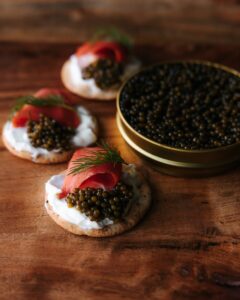Is There Any Sustainable Caviar?
 Diet trends inspired by climate activism are sparking questions in every corner of the food industry. Now, it has hit caviar. A single species provides this dish commonly associated with high-class, fine dining — the sturgeon. Add a little salt, and you have caviar. Many environmentalists advocate for a diet free of animal products, but food enthusiasts want to know if there is any way sustainable caviar could be a possibility.
Diet trends inspired by climate activism are sparking questions in every corner of the food industry. Now, it has hit caviar. A single species provides this dish commonly associated with high-class, fine dining — the sturgeon. Add a little salt, and you have caviar. Many environmentalists advocate for a diet free of animal products, but food enthusiasts want to know if there is any way sustainable caviar could be a possibility.
What Would Constitute Sustainable Caviar?
Sustainable caviar would house sturgeons in controlled environments that are as similar to their native habitats as possible. The fish would have the freedom and space to swim and adequate access to nutrient-rich food sources. Surrounding flora would comprise the same algae and other plants that support sturgeon growth.
The environment must also provide them comfort and respect, ensuring the fish’s safety and well-being at every moment. Supervision includes medical treatment to prevent disease and letting them live as long and happy lives as possible. At no point should they feel like they are in captivity.
Experts in sustainable caviar sourcing promise more ethical conditions to make their meals taste better. The benefit comes from having physically and emotionally healthier sturgeons in well-tended, pure water sources free of pollutants. It keeps the product clean and fresh while forcing the companies maintaining the aquatic bodies to consider their water awareness and interactivity.
Finally, aquaculture wouldn’t be sustainable if fishery owners engaged in overfishing. Fish farms should let the population recover and not diminish the supply.
How Do Sustainability Goals Make Caviar More Complex?
Environmental awareness also requires transparency. Aquafarms that want the planet and species to thrive pay attention to legislation, compliance frameworks and regulations to convey their adherence to customers. Therefore, sustainable caviar must have an easy-to-trace farm as close to home as possible. The organization should publicize its sustainability commitments and frequently reflect on how to make things even better for sturgeons.
Additionally, traveling thousands of miles means the caviar needs additives, preservatives or special heat treatment processes to keep it from spoiling in transit. Caviar’s climate impact is reduced if it doesn’t have to go through multiple brokers and third parties to reach its destination. Often, this degrades the product and emits unnecessary emissions along the way.
Sustainable caviar also requires more action from providers — this means advocacy. Populations have dwindled in light of the caviar craze, and everyone in the business must shoulder that responsibility. Rehabilitation, repopulating and rewilding sturgeons safely and ethically to restore numbers is crucial for keeping ecosystems balanced and caviar chefs on the right side of history.
Instead of gathering as many sturgeons as possible to extract high quantities of roe, ethical fisheries operate on a 1:1 feed ratio. Farmers return as much as they take, though more aggressive measures might be necessary if fish populations keep declining.
You may not make the connection of how taking eggs away from sturgeons would impact the population. Some may even wonder how it differs from an industry like chicken eggs. If the animal produces the product naturally without pain, what harm does it do to take eggs away from them?
How Are Caviar-Harvesting Methods Unsustainable?
Caviar farming is rife with overfishing and questionable operations. Fishers extract the females from families and inhumanely scrape the ovaries of roe. Most of the time, the mother sturgeon dies while her eggs are obtained. In some cases, fisheries discard the mother and only keep the roe — making this a vastly different case compared to chickens.
Many providers prioritize profit and demand over the health of the fish. Sturgeon life cycles range from six to 14 years, depending on the species, so you can imagine fish farmers haven’t let the populations recover entirely.
The International Union for the Conservation of Species awarded the family sturgeons are in as the most at-risk animal group for extinction mainly due to the 500 tons of caviar produced annually. Several sturgeon species are endangered because of the caviar market, including:
- Beluga sturgeon
- Dabry’s sturgeon
- Yangtze sturgeon
- Chinese sturgeon
Most wild-caught caviar is against the law. Around 31% of Danube and Black Sea caviar was bought and sold illegally. The Caspian Sea is another ecosystem destroyed by sturgeon abuse. Sustainable caviar advocates must raise awareness of poaching to save what species remain and only source caviar from monitored fisheries.
What Do Sustainable Caviar Operations Look Like?
If a company is going to offer caviar products, the first tenet they must hold is a no-kill philosophy. There are ways to obtain the roe without killing mature females so they can continue to live. Providers and restaurants should also consider supplementing ethically sourced options with plant-based alternatives, like seaweed or couscous caviar. It reduces pressure on the sturgeon population while giving food lovers the desired experience without killing animals.
These innovations could change the purity mindset of fine dining into something more inclusive and considerate to the planet. Plant-based diets require fewer natural resources and don’t compromise flavor or experience.
Eco-friendly aquaculture is the next big ticket item. Crafting the perfect environment requires heavy research into a sturgeon’s natural habitat. Knowing the behavior and biology helps, especially considering how the fish adapted and acclimated to the aquatic regions they inhabit. Drastic variances could disrupt their development and well-being.
Sustainable operations are more than restaurants trying to make caviar as ethically as possible. It also includes sturgeon conservation and efforts to reduce environmental fragmentation caused by dams and other invasive infrastructure projects.
Whether you run a restaurant, are responsible for sourcing caviar or eat it, every group must do their part to expand their perspective on the crises sturgeons face because of human influences.
Is Sustainable Caviar Possible?
The question is almost impossible to answer, given animal products’ reputation for contributing to climate change. Fish is almost — if not more — guilty than the meat market regarding unethical business practices and environmentally damaging legacies.
However, the industry must shift to kinder operations if the world continues serving caviar. Caviar producers must do their part to help sturgeon outside of their financial enterprises — only then is it genuinely as sustainable as possible.


